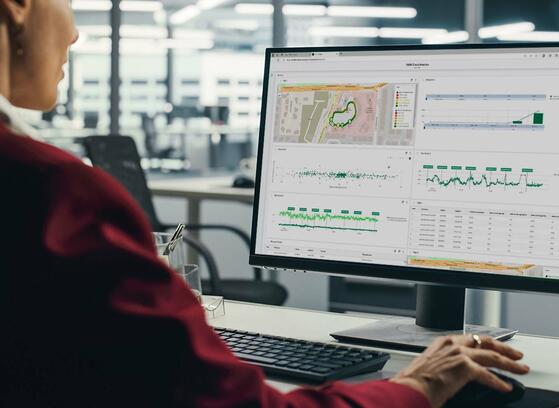Drive testing remains essential for ensuring optimal network performance, especially as 5G deployments introduce greater complexity. However, traditional methods need to evolve with the times. Operators need faster, more efficient ways to validate network quality while reducing costs.
To achieve this, a focus on operational efficiency is critical. From a drive testing standpoint this includes aspects such as determining optimal drive routes, minimizing testing time, ensuring right-first time testing, and reducing the time from drive test to completion of data analysis.
The challenges of traditional drive testing
Let's explore the key challenges in drive testing and how strategies that include automation and cloud analytics are making the process more efficient.
- High operational costs – Drive testing can be expensive due to the engineering time and resources required to gather the necessary data from the field. At a time when businesses are focused on improving operational efficiency, the ROI of drive testing needs to be improved.
- Delayed results – Since the same engineers are typically responsible for testing and data analysis, it can often be days before drive test reports are issued and network issues that were discovered are solved. Additionally, with the success of many operators resting on their 5G network deployment, management expects regular and up-to-date reporting on the status of the deployment and the performance of the network. The time from drive test to result needs to be reduced.
- Inconsistent testing methods – When every drive tester is responsible for configuring their own testing they can analyze that data and gain the required insights, but it is hard for other engineers to easily extract information from their log files, and it is even harder to compare performance across drive testers and leverage the data collected in macro analysis.
The message is clear: manual testing alone can’t keep pace with modern network demands. To address this, several transformations have been happening within network testing:
- Automation is being used to ensure consistent testing across teams and significantly faster processing and analysis of drive test data.
- The interest in network testing analytics has grown significantly, pointing to the desire of operators to ensure they maximize the value from every drive test they undertake.
How to modernize drive testing
To stay competitive, operators must adopt smarter drive testing strategies and tools that provide automation and cloud-based analytics like TEMS™ Cloud.
In a recent webinar, where we explored how to streamline drive testing analysis and reporting, we asked attendees where they saw the greatest benefit from network testing automation and analytics. An overwhelming majority of the audience saw automated data analysis and root cause identification as the capabilities that brought the most value to their daily activities.
These results clearly support the following four strategies as critical to success in performing more effective drive testing:
1. Automate data collection & processing
In drive testing, delays in data processing create costly bottlenecks. Traditional workflows mean data analysis could be delayed by days. This results in longer than necessary issue resolution times and outdated information in management reports.
How to overcome this?
- Use automated logfile uploading, processing and analysis to shorten time to result.
- Leverage cloud-based tools like TEMS Cloud to reduce processing time and gain faster insights.
When teams can analyze network performance faster, they can fix issues faster, often before users notice them.
How TEMS Cloud analytics helps: Its rapid logfile processing (25x faster than legacy systems) ensures data is available for analysis much faster.
2. Implement root cause analysis
Manually shifting through drive data to find the cause of a dropped call or poor throughput is like searching for a needle in a haystack. It’s time-consuming, and relies heavily on individual expertise.
What should you have at your side to avoid this?
- Automated triage that flags known issues instantly, so engineers spend less time diagnosing and more time fixing.
- Customizable KPIs that ensure the analysis aligns with your unique requirements, whether you’re optimizing dense urban 5G or rural LTE.
How TEMS Cloud analytics helps: Its rule-based RCA and custom KPI engine can reduce troubleshooting time by 50%, letting teams focus on solutions, not data mining.
3. Standardize testing & reporting
Inconsistent methodologies create problems. Different teams using different testing approaches and reporting formats make cross-market comparisons unreliable. Leadership then gets fragmented insights, delaying critical decisions.
Why does standardization win?
- Unified testing protocols ensure consistent comparisons.
- Automated reports ensure uniformity and reduce time to distribution.
- Pre-built dashboards give leadership up-to-date visibility.
How TEMS Cloud helps: Its centralized project management and templated reporting can cut manual work by 8-10x, so teams spend less time formatting and more time optimizing.
4. Integrate with broader network data sets
Drive tests alone can’t tell the full story in every situation. By correlating with additional data sources, you gain further insights to highlight the true cause of an issue.
To shift to an integrated approach:
- Combine drive test data with network call traces to improve customer complaint resolution.
- Layer in crowdsourced insights to prioritize high-impact areas which require drive testing.
- Feed drive test findings into SON systems to improve closed-loop optimization.
How TEMS Cloud enables this: Its open APIs merge drive analytics with OSS/BSS systems, turning isolated data sets into a continuous optimization engine.
TEMS Cloud: The solution for a smarter approach to analyzing drive testing data
The drive testing analytics provided by TEMS Cloud enables operators to implement these four strategies by bringing automation, speed, and intelligence to drive testing projects.
Benchmarks show that operators get:
- Faster data processing: Cuts logfile loading by 80% due to refined data, new processing components and cloud scalability.
- Automated issue detection: Triage, automation and RCA reduce troubleshooting time by 50%.
- Optimized costs: Operators experience 30% reduction in IT infrastructure and overheads thanks to cloud architecture.
The future of drive testing is automated
The old way of analyzing drive testing data (slow and manual) no longer works for modern customer-centric networks. Operators applying modern drive testing strategies and solutions address challenges more efficiently by:
- Automating data collection, processing and analytics to reduce the time to result.
- Standardizing test protocols across the organization to ensure data integrity.
- Integrating with broader network data sets for increased context-aware optimization.
See how TEMS Cloud analytics applies these principles or contact a TEMS expert to address your specific challenges.

Related resources:









